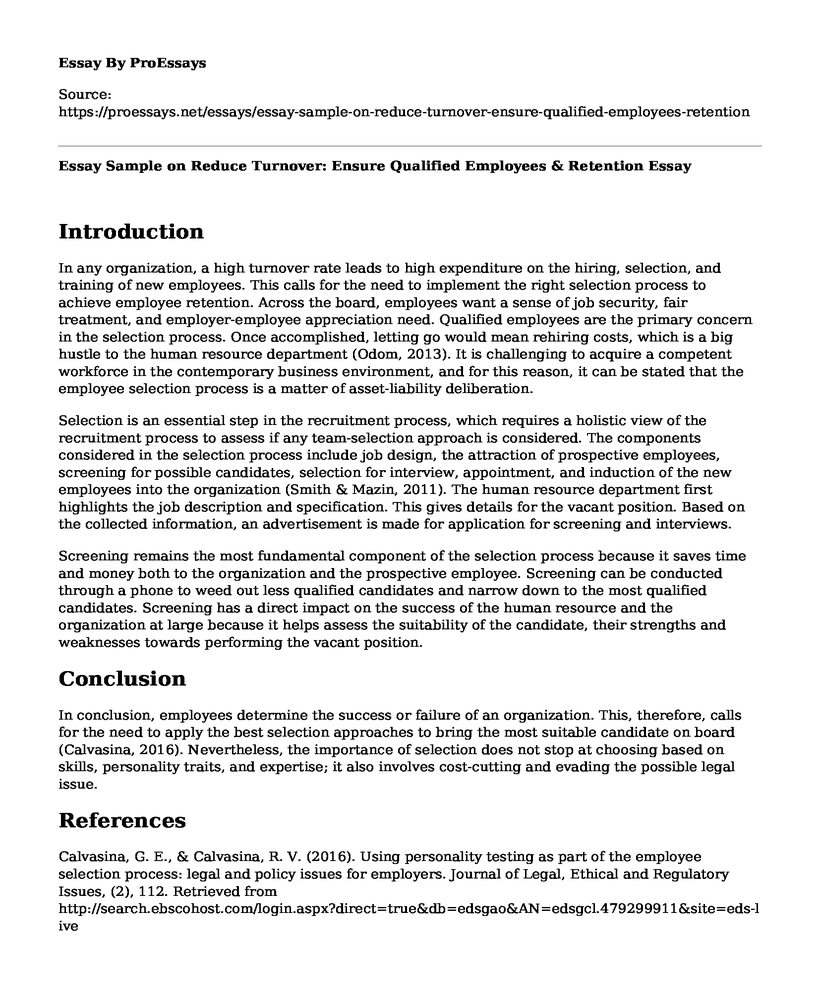Introduction
In any organization, a high turnover rate leads to high expenditure on the hiring, selection, and training of new employees. This calls for the need to implement the right selection process to achieve employee retention. Across the board, employees want a sense of job security, fair treatment, and employer-employee appreciation need. Qualified employees are the primary concern in the selection process. Once accomplished, letting go would mean rehiring costs, which is a big hustle to the human resource department (Odom, 2013). It is challenging to acquire a competent workforce in the contemporary business environment, and for this reason, it can be stated that the employee selection process is a matter of asset-liability deliberation.
Selection is an essential step in the recruitment process, which requires a holistic view of the recruitment process to assess if any team-selection approach is considered. The components considered in the selection process include job design, the attraction of prospective employees, screening for possible candidates, selection for interview, appointment, and induction of the new employees into the organization (Smith & Mazin, 2011). The human resource department first highlights the job description and specification. This gives details for the vacant position. Based on the collected information, an advertisement is made for application for screening and interviews.
Screening remains the most fundamental component of the selection process because it saves time and money both to the organization and the prospective employee. Screening can be conducted through a phone to weed out less qualified candidates and narrow down to the most qualified candidates. Screening has a direct impact on the success of the human resource and the organization at large because it helps assess the suitability of the candidate, their strengths and weaknesses towards performing the vacant position.
Conclusion
In conclusion, employees determine the success or failure of an organization. This, therefore, calls for the need to apply the best selection approaches to bring the most suitable candidate on board (Calvasina, 2016). Nevertheless, the importance of selection does not stop at choosing based on skills, personality traits, and expertise; it also involves cost-cutting and evading the possible legal issue.
References
Calvasina, G. E., & Calvasina, R. V. (2016). Using personality testing as part of the employee selection process: legal and policy issues for employers. Journal of Legal, Ethical and Regulatory Issues, (2), 112. Retrieved from http://search.ebscohost.com/login.aspx?direct=true&db=edsgao&AN=edsgcl.479299911&site=eds-live
Odom, C. L. (2013). New-Hire Retention Woes Drive Change in Health Insurer's Employee-Selection Process. Global Business & Organizational Excellence, 32(6), 27-35. https://doi.org/10.1002/joe.21512
Smith, S., & Mazin, R. (2011). Employee Selection: How Do I Find, Attract, and Select the Best? In The HR Answer Book: An Indispensable Guide for Managers and Human Resources Professionals (pp. 1-34). New York; Atlanta; Brussels; Chicago; Mexico City; San Francisco; Shanghai; Tokyo; Toronto; Washington, D.C.: AMACOM Division of American Management Association International. Retrieved from http://www.jstor.org/stable/j.ctt1d2r00h.4
Cite this page
Essay Sample on Reduce Turnover: Ensure Qualified Employees & Retention. (2023, Jan 30). Retrieved from https://proessays.net/essays/essay-sample-on-reduce-turnover-ensure-qualified-employees-retention
If you are the original author of this essay and no longer wish to have it published on the ProEssays website, please click below to request its removal:
- The Effect of China's Demand for Iron Ore on the Australian Economy
- Feeling Unmotivated: My Story of Finding Employee Motivation - Essay Sample
- Paper Example on Creating a Business Plan for a Start-up Bistro/Coffeehouse
- Paper Example on Integrating DESC & CR Models for Civility in Organizations
- Paper Example on Recruiting and Developing Competent Leaders: Key to Institutional Success
- Paper Sample on Capstone Corp Dismissal: Paula's Right to Free Speech
- Paper Example: Strategic Employee Selection and Recruitment Methods for Sleep Tight Inn







